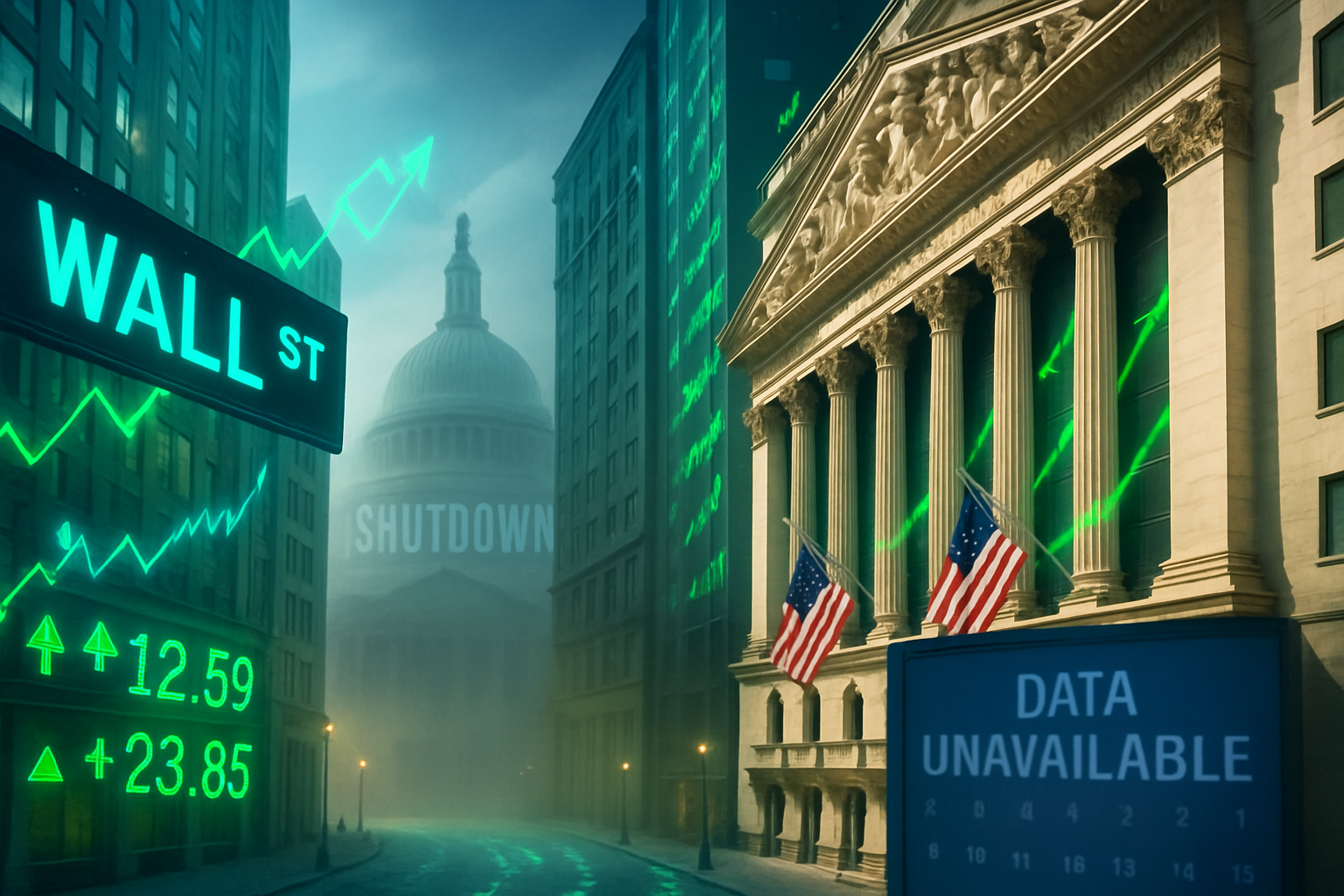
As the U.S. government grapples with an ongoing shutdown, Wall Street has once again demonstrated its remarkable resilience, not only shrugging off political paralysis but also surging to new record highs. This unexpected climb, observed even as crucial economic data like the monthly jobs report remains delayed, highlights a growing disconnect between political turmoil in Washington D.C. and the underlying optimism driving financial markets. Investors appear to be looking beyond the temporary disruption, focusing instead on strong corporate fundamentals, technological advancements, and the persistent anticipation of Federal Reserve interest rate adjustments.
The current scenario, unfolding as of early October 2025, sees major indices like the Dow Jones Industrial Average (DJIA) and the S&P 500 (SPX) repeatedly setting new closing records. This robust performance, despite the 'data blackout' caused by the shutdown, underscores a market increasingly driven by factors such as robust corporate earnings and the transformative potential of artificial intelligence. The delayed release of official jobs data, while creating uncertainty, has paradoxically fueled speculation around potential Federal Reserve rate cuts, further bolstering investor confidence and contributing to the market's upward trajectory.
Market Resilience in the Face of Political Paralysis
The current government shutdown, which commenced on October 1, 2025, has swiftly become a testament to Wall Street's ability to navigate political headwinds. Despite the cessation of non-essential government services and the furlough of hundreds of thousands of federal employees, the financial markets have not only held steady but have actively pushed into uncharted territory. On October 1, the Dow Jones Industrial Average (DJIA) (NYSE: ^DJIA) immediately set a new record, a trend that continued for three consecutive days, with both the S&P 500 (SPX) (NYSE: ^SPX) and the Dow achieving closing records by October 3. The Nasdaq Composite (IXIC) (NASDAQ: ^IXIC), heavily weighted towards technology, also reached an all-time high, signaling broad-based market strength.
This rally is not an isolated incident but rather fits a historical pattern of market resilience during government shutdowns. The 2013 shutdown saw the S&P 500 gain approximately 3.1%, and the much longer 2018-2019 shutdown coincided with a significant 10.3% rise in the S&P 500, largely attributed to a dovish shift by the Federal Reserve (Federal Reserve System). This precedent suggests that investors often perceive these political impasses as temporary, with minimal long-term economic damage. The market's current momentum is fueled by strong corporate earnings reports from major tech companies (e.g., Apple (NASDAQ: AAPL), Microsoft (NASDAQ: MSFT), Nvidia (NASDAQ: NVDA)), continued enthusiasm for advancements in artificial intelligence, and growing expectations that the Federal Reserve will implement further interest rate cuts to stimulate economic activity.
A critical aspect of the current shutdown's market impact is the 'data blackout.' Key economic indicators, including the highly anticipated monthly jobs report from the Bureau of Labor Statistics, GDP growth figures from the Bureau of Economic Analysis, and various reports from the Census Bureau, have been suspended. This absence of official, comprehensive data leaves policymakers, particularly the Federal Reserve, in a challenging position, often described as 'flying blind' when assessing the true state of the economy. In response, investors and economists have increasingly turned to alternative, private-sector data, such as the ADP private payroll report, to glean insights into labor market health. While these private reports offer some guidance, they are generally considered less robust and comprehensive than their government counterparts, introducing an element of uncertainty.
Paradoxically, the ambiguity created by delayed official data has, in some instances, bolstered market optimism. Weaker-than-expected private-sector reports, in the absence of contradictory government data, have been interpreted by some as increasing the likelihood of Federal Reserve rate cuts. This expectation of lower borrowing costs acts as a powerful stimulant for equity markets, overriding concerns about the government shutdown itself. Key stakeholders involved in this dynamic include the U.S. Treasury, responsible for managing federal finances; the Federal Reserve, tasked with monetary policy; and a diverse array of institutional and retail investors who are constantly recalibrating their portfolios in response to both political developments and economic signals.
Corporate Winners and Losers in the Shutdown's Shadow
While the broader market celebrates new highs, the impact of the government shutdown is far from uniform across public companies. Industries with significant ties to federal spending, regulatory oversight, or government services face direct and often severe headwinds. Government contractors, particularly smaller firms, are among the hardest hit, experiencing payment delays, contract suspensions, and procurement freezes. Larger defense contractors like Northrop Grumman (NYSE: NOC) and Lockheed Martin (NYSE: LMT), with their extensive long-term contracts, are generally more insulated due to the strategic importance of defense spending. However, even these giants can face delays in new project approvals or modifications.
Highly regulated sectors also bear the brunt of the shutdown. Biotechnology and pharmaceutical companies, for instance, face costly delays in drug trial approvals from the Food and Drug Administration (FDA). Similarly, the energy sector, particularly oil and gas producers requiring permits for drilling on federal lands, can experience significant operational setbacks. The financial services industry also sees operational hurdles, with delays in regulatory approvals, mortgage processing (e.g., FHA approvals), and Small Business Administration (SBA) loan processing. Companies awaiting Securities and Exchange Commission (SEC) approvals for IPOs, mergers, or new product clearances face expensive and time-consuming backlogs.
Conversely, some sectors and companies demonstrate remarkable resilience or even benefit from the prevailing uncertainty. Gold miners, such as Newmont Corporation (NYSE: NEM), often see increased demand as gold serves as a traditional safe-haven asset during political turmoil. Consumer staples and discount retailers, including giants like Walmart Inc (NYSE: WMT), tend to perform well as consumers, especially furloughed federal workers, prioritize essential goods and value-oriented purchases. Utilities and healthcare companies, like UnitedHealth Group (NYSE: UNH), are considered defensive sectors due to the consistent demand for their essential services, which remains stable regardless of economic or political conditions.
The 'data blackout' caused by the shutdown further complicates corporate decision-making. Businesses typically rely on official government data, including jobs reports, GDP figures, and inflation indicators, for strategic planning, capital allocation, and workforce adjustments. Without this timely and accurate information, companies operate with heightened uncertainty, making it harder to assess market conditions and forecast future demand. While some firms turn to private data sources like the ADP employment report, these often lack the comprehensive depth of government statistics, potentially leading to suboptimal investment decisions and increased market volatility.
Broader Implications and Historical Context
The current market phenomenon of record highs amidst a government shutdown highlights a significant and evolving trend: the increasing disconnect between political gridlock in Washington D.C. and the underlying drivers of the U.S. financial markets. This resilience suggests that investors are increasingly viewing government shutdowns as temporary political skirmishes rather than fundamental threats to economic stability. The market's focus has evidently shifted towards robust corporate earnings, particularly from the booming technology sector, and the transformative potential of innovations like artificial intelligence, which appear to transcend short-term political machinations.
However, the ripple effects of an ongoing shutdown extend far beyond the immediate market sentiment. Furloughed federal workers and unpaid contractors face significant financial hardship, leading to reduced consumer spending, particularly in regions with high concentrations of federal employees. This can create a localized economic drag, impacting small businesses and service industries. While the broader market may initially absorb these shocks, a prolonged shutdown compounds these issues, potentially reducing annualized quarterly GDP growth by an estimated 0.1-0.2 percentage points for each week it continues. This economic leakage, while not always immediately reflected in major indices, represents a tangible cost to the economy.
From a regulatory and policy standpoint, an ongoing shutdown creates substantial backlogs. Agencies like the SEC, FDA, and EPA cease or significantly curtail operations, delaying critical approvals for new drugs, mergers, environmental projects, and financial product launches. These delays can cost businesses millions and stifle innovation for months even after the government reopens. The repeated occurrence of shutdowns also raises questions about the stability and predictability of U.S. fiscal governance, potentially creating a persistent 'risk premium' for U.S. assets over the long term and undermining international confidence in the country's political stability.
Historically, Wall Street has often demonstrated resilience during short government shutdowns. For instance, the S&P 500 gained during both the 2013 and 2018-2019 shutdowns. These precedents suggest that investors anticipate a resolution and a subsequent 'catch-up' in economic activity. However, the current environment, marked by a 'data blackout' and reliance on less comprehensive private data, adds a layer of complexity. While this lack of official data has paradoxically fueled speculation for Federal Reserve rate cuts, it also means that both policymakers and investors are operating with an incomplete picture of the economy, increasing the potential for misjudgment if the shutdown extends significantly.
Navigating the Path Ahead
In the short term, the market's trajectory remains heavily influenced by the duration of the government shutdown and the eventual release of delayed economic data. A swift resolution could lead to a 'relief rally' as certainty returns and pent-up economic activity is unleashed. The immediate release of the comprehensive jobs report and other key indicators will be crucial, providing the Federal Reserve with a clearer picture for its monetary policy decisions. Should the data confirm underlying economic strength, it might temper rate cut expectations, while weaker data could reinforce them, potentially leading to further market gains driven by anticipated Fed easing.
However, a prolonged shutdown presents a more challenging outlook. The cumulative economic drag, the growing regulatory backlogs, and the increasing financial strain on federal workers and contractors could eventually erode consumer confidence and corporate earnings, potentially leading to increased market volatility. Businesses, particularly those reliant on government interaction, may be forced to implement strategic pivots, such as diversifying revenue streams away from federal contracts, investing in automation to mitigate workforce disruptions, or seeking international markets less susceptible to U.S. political gridlock. The tech sector, with its global revenue and less direct government dependence, might continue to show resilience, but even they could face challenges from a broader economic slowdown.
Looking long-term, the recurring nature of government shutdowns poses a fundamental challenge to the U.S. economy's stability and predictability. This could lead to a permanent reassessment of risk by international investors, potentially increasing borrowing costs for the U.S. government and impacting the dollar's global standing. Market opportunities may emerge in sectors that are genuinely insulated from political machinations or those that offer solutions to mitigate the impact of future shutdowns, such as resilient supply chain technologies or alternative data providers. The biggest challenge remains restoring confidence in fiscal governance, which is essential for sustainable economic growth and a stable investment environment.
Concluding Thoughts and Investor Watchpoints
The ongoing government shutdown in October 2025 has presented a fascinating paradox: while Washington D.C. grapples with political paralysis, Wall Street has surged to new record highs, fueled by robust corporate earnings, the AI boom, and the anticipation of Federal Reserve rate cuts. This resilience underscores a market that has increasingly learned to 'look through' temporary political disruptions, focusing instead on deeper economic and technological currents. However, this broad market strength masks significant challenges for specific sectors and companies directly impacted by federal operations and the 'data blackout.'
Moving forward, the market's trajectory will be keenly sensitive to the duration of the shutdown and the clarity that emerges once official economic data is released. Investors should closely monitor not only the headlines from Washington but also the Federal Reserve's communications, corporate earnings reports (especially from bellwether tech companies), and any shifts in consumer spending patterns. While the immediate market reaction has been surprisingly positive, a prolonged shutdown could eventually trigger a more fundamental reassessment of economic health and investor confidence.
The lasting impact of this event lies in its reinforcement of the market's ability to compartmentalize political risk, at least in the short term. However, it also highlights the hidden costs of political dysfunction, from regulatory backlogs to localized economic strains. For investors, the key takeaway is the importance of a diversified portfolio and a clear understanding of a company's exposure to government-related risks. As the situation evolves, agility and informed decision-making will be paramount to navigating both the opportunities and the challenges that emerge from this unique confluence of political gridlock and market exuberance.
This content is intended for informational purposes only and is not financial advice





